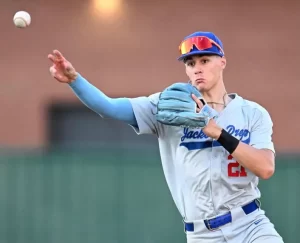The tall and short of White Sox draft strategy
Last year after the 2015 First Year Player Draft, I was reviewing the White Sox class and noticed something that stuck out. It seemed they drafted a pretty significant number of relatively short prospects (under six feet tall). This led me down a rabbit hole of data, and into a brief conversation with Amateur Scouting Director Nick Hostetler. But I elected to wait until the 2016 draft, to see if there was a legitimate pattern.
In short, the data shows the White Sox do seem to have a pattern around the height of their selections – both position players and pitchers. And the pattern in one of those cases varies meaningfully from apparent norms in MLB among other teams. We will focus on 2015 and 2016, because those are the two drafts for which the current managers in that department have been in control, then compare to previous years under different direction.
Setting the Bar
Let’s set some base data first. The sources for the overall MLB data included Beyond the Box Score, Baseball Prospectus, ESPN and even Wikipedia and other encyclopedic sites. Here are the key parameters to be aware of:
- The average player in MLB overall is about 6’2″, though different sources have some variance.
- Pitchers are typically a little taller, somewhere just over 6’2″, with position players a little below.
- First basemen are tallest among position players at an average of 6’3″, and the averages slide down to second baseman at 5’11” on the short end.
- Heights of the White Sox draftees we list in this article are taken from listings provided at draft time, typically via MLB.com’s draft tracker.
- Those heights can sometimes contain variability depending on source, and shouldn’t be seen as hyper-accurate. Pitchers in particular seem to have an unnaturally high number of players exactly six feet tall. But across a large number of players, the bias evens out across teams, so it probably isn’t worth much concern in this analysis.
- The average American male is about 5’10”, so just to be clear, professional baseball players as a group are taller than the general population.
Position Players
Here’s what we have for data points among White Sox draftees in 2015, position players only, who actually signed:
- The average height was 5 feet, 11.3 inches tall
- 8 of the 15 players were less than 6 feet tall, and just 2 were taller than 6’1″ (both were first basemen – Corey Zangari and Sikes Orvis)
- The shortest player taken was Bradley Strong at 5’8″
- Zangari was the only player selected that was materially taller than the average MLB position player (he’s 6’4″), and Orvis was right around average at 6’2″
Of course, even with 15 players, that could be a sample size issue. So what about the next year? In 2016 we see this:
- The average player taken was 6 feet, 1 inch tall
- There were only 2 players taken in this class that were less than 6′, and both were 5’11” (Alex Call and Sam Dexter)
- Even though the average height was taller than 2015, just 3 of 14 players are taller than MLB average: catcher Zack Collins and first baseman Anthony Villa at 6’3″, and outfielder Aaron Schnurbusch at 6’5″
When you average out across the two drafts, you get 6 feet on the nose. That’s about 2 inches shorter than the average MLB player. Wondering if this was a direct or side effect of some intentional approach, I asked Hostetler last year about the shorter players. Here is what he said at the time:
“I wish I could tell you we had unearthed some data or theory that said taking shorter players produced a certain type of ML player, but I can’t. It was just the way the draft fell. The main thing we do in the draft is is to try and find the best available player in that round. It just so happened that the best player in each round may have been a tick shorter than others in previous years. The way we look at it is we would much rather have a 5’10” player that can play as opposed to a 6’3″ player who can’t.”
In other words, there’s no apparently intentional logic that goes on here. In fact, they seem to specifically want to focus on baseball skills. So is it just coincidence?
One thing we’ve heard generally from this front office, including Hostetler on multiple occasions, is more of an emphasis on “ballplayers”. This is somewhat different than the multi-sport pure athletes that dominated the high rounds in the few years prior (see Courtney Hawkins, Keenyn Walker, Jared Mitchell, and even Tim Anderson). There could be a correlation there, but that would just be a guess.
So what if we go back to the drafts before the current, Hostetler-led regime? In the 2012 to 2014 period, the average height of the players taken was 6 feet, 1.5 inches. That is right around MLB average, and about an inch and a half more than the 2015-2016 period. So we have more evidence that the new approach from Hostetler and company ends up giving them shorter players, even if unintentionally.
Pitchers
What about the pitching side? Before I even checked the numbers, I asked Hostetler about this side of the field. In this case, he was more specific:
“In a perfect world, yes we would like taller pitchers. It’s easier to create angle and there usually is more projection in a taller pitcher. But if the 6 footer has premium stuff and is able to create angle then we’re fine with a shorter pitcher. We are open to adapting the stuff and pitch ability more than size.”
So with pitchers, they do like tall, though not as a dominant factor. Now let’s see what influence that may have had, in the end. Here is the 2015 draft:
- The average pitcher selected and signed was 6 feet, 3.1 inches tall
- Of 17 pitchers, only one was under 6 feet (Alex Katz at 5’10”), and just two more were listed at 6′ even (Carson Fulmer and Ryan Riga)
- 11 of the 17 were 6’3″ or taller, which is to say, taller than average
- The tallest was Taylore Cherry at 6’9″
And now 2016:
- The average pitcher selected and signed was 6 feet, 2.8 inches
- Of the 15 pitchers, again just one was under 6′ (Michael Horejsei at 5’10”), and another 4 at 6′ flat (Ian Hamilton, Ben Wright, Matt Foster, Pat Cashman)
- 8 of the 15 were 6’3″ or taller, or above average
- The tallest were Alec Hansen and Jake Elliott, both listed at 6’7″
Looking across both years, you get an average height of just under 6’3″. So yes, that’s more length than the average MLB hurler, but only by maybe half or three-quarters of an inch. That’s not as significant a variance as we saw with position players, but it reflects what Hostetler said – they like taller pitchers, but it’s not the highest priority focus.
For comparison, looking at the 2012-2014 period under the previous regime, you get pretty much exactly 6’3″. So in the case of pitchers, the current scouting leadership doesn’t seem to be making changes that express themselves by height of signed players.
What is different and what isn’t?
The short story is, on the position player side, there appears to be a statistically meaningful tendency. The current White Sox approach ends up with shorter players drafted and signed, though it seems that is a side effect, not an intended outcome. On the pitching side, the team is right around average or perhaps a little on the tall side compared to all of MLB, and that has not varied with recent management changes.
When the 2017 draft comes around, keep an eye on the position players, and see if the trend continues.
Want to know right away when we publish a new article? Type your email address in the box and click the “create subscription” button. Our list is completely spam free, and you can opt out at any time.






